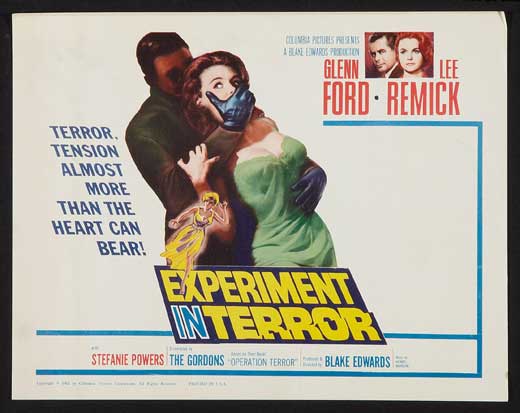The Golden Gate Bridge, trolley cars, Candlestick Park… why, Experiment in Terror is only a pot of Rice-A-Roni away from being the ultimate San Francisco treat. Corny jokes aside, this picture was the opening salvo of a powerhouse year for director Blake Edwards. Sure, the following year would find him directing the film destined to become his signature—The Pink Panther—but he began 1962 with this tense thriller and ended with Days of Wine and Roses. Both films share not only Edwards’ guiding hand, but also indelible music by Henry Mancini, sumptuous black-and-white cinematography by Philip H. Lathrop, and leading lady Lee Remick.
I came to Experiment in Terror knowing almost nothing about it, though intrigued by the idea of Edwards directing a hard-boiled, nourish, and at times perverse piece of taut suspense. This semi-forgotten classic arrives on Blu-ray via Twilight Time in a release limited to 3,000 copies. Fifty-one years later, the film holds a captivating power, buoyed by Remick’s deer-in-the-headlights turn as Kelly Sherwood, a bank employee under the control of a maniacal killer. That killer, a leering, wheezing, all-around uncouth scoundrel by the name of Red Lynch, is played by Ross Martin (later immortalized as Artemus Gordon in television’s The Wild Wild West). The most memorable cat-and-mouse crime thrillers are usually buoyed by the strength of their villains. Martin excels as Lynch, who demands Kelly steal $100,000 from the bank she works in. He was duly recognized with a Golden Globe nomination for Best Supporting Actor.
Experiment in Terror cover (190×250).jpgThe opening sequence immediately plunges us into Kelly’s plight. She’s accosted by Lynch in her garage upon returning home from work. The man knows everything about her, including that her younger sister, Toby (Stefanie Powers), lives with her. If the threat to her own life isn’t enough to keep her from contacting the authorities, Lynch figures Kelly will comply to ensure Toby’s well-being. To her credit, Kelly’s no dummy—she contacts the FBI almost immediately, establishing a valuable relationship with G-man John Ripley (a stalwart Glenn Ford). As Edwards ratchets up the tension, several rather lurid surprises (for 1962, at least) await, building to a chaotic climax at a Giants-Dodgers game.
Twilight Time’s Blu-ray offers an excellent presentation of Experiment in Terror’s two secret weapons: Philip H. Lathrop’s cinematography and Henry Mancini’s score. Visually, the 1080p transfer highlights the stark beauty of Lathrop’s B&W imagery. This is the kind of work that makes one wish more films were being shot this way (though in the digital era, perhaps black-and-white cinematography truly has become a lost art). From the deepest blacks to all the various shades of gray, this transfer is a pleasure to look at. Close-ups feature stunning detail and the source print is in great shape from head to tail.
The audio is offered as a DTS-HD Master Audio 5.1 mix, which might upset purists seeking a historically accurate mono presentation. I’m kind of in that camp myself, always preferring to see the option of a film’s original audio format. That said the mix is a knockout. Surround activity is quite limited, though music and occasional effects do spill over into the rears from time to time. What’s most striking about the sound design is the hyper-realism of sounds such as a girl screaming playfully while jumping into a pool, blaring sirens, even the simple ring of a phone. These commonplace effects have been pushed to an extreme in the mix, and the result is effectively jarring.
And then there’s Mancini’s jazz-inflected score; foreboding and always evocative of the film’s queasy mood. As usual with Twilight Time releases, an isolated score track is available in DTS-HD MA 2.0 and for anyone interested in film scoring, this one’s definitely worth spending a little time with. I will admit, I often wonder just how many people watch an entire film while only listening to the score. But Mancini’s work here is a brilliant study in the less-is-more school of film scoring. Watching with only the score is a lesson in how to maximize the impact of every cue.
As for supplementary material, we’re limited to a pair of theatrical trailers and a pair of TV spots. Julie Kirgo’s essay in the accompanying booklet is essential. So good are her essays for these Twilight Time releases, I’ve come to read them only after writing my review for fear of subconsciously regurgitating everything she says. Her essay covers the bases and provides historical context for why Experiment in Terror is a must-see film. Twilight Time’s limited edition Blu-ray can be purchased exclusively, while supplies last, through their distributor Screen Archives.

